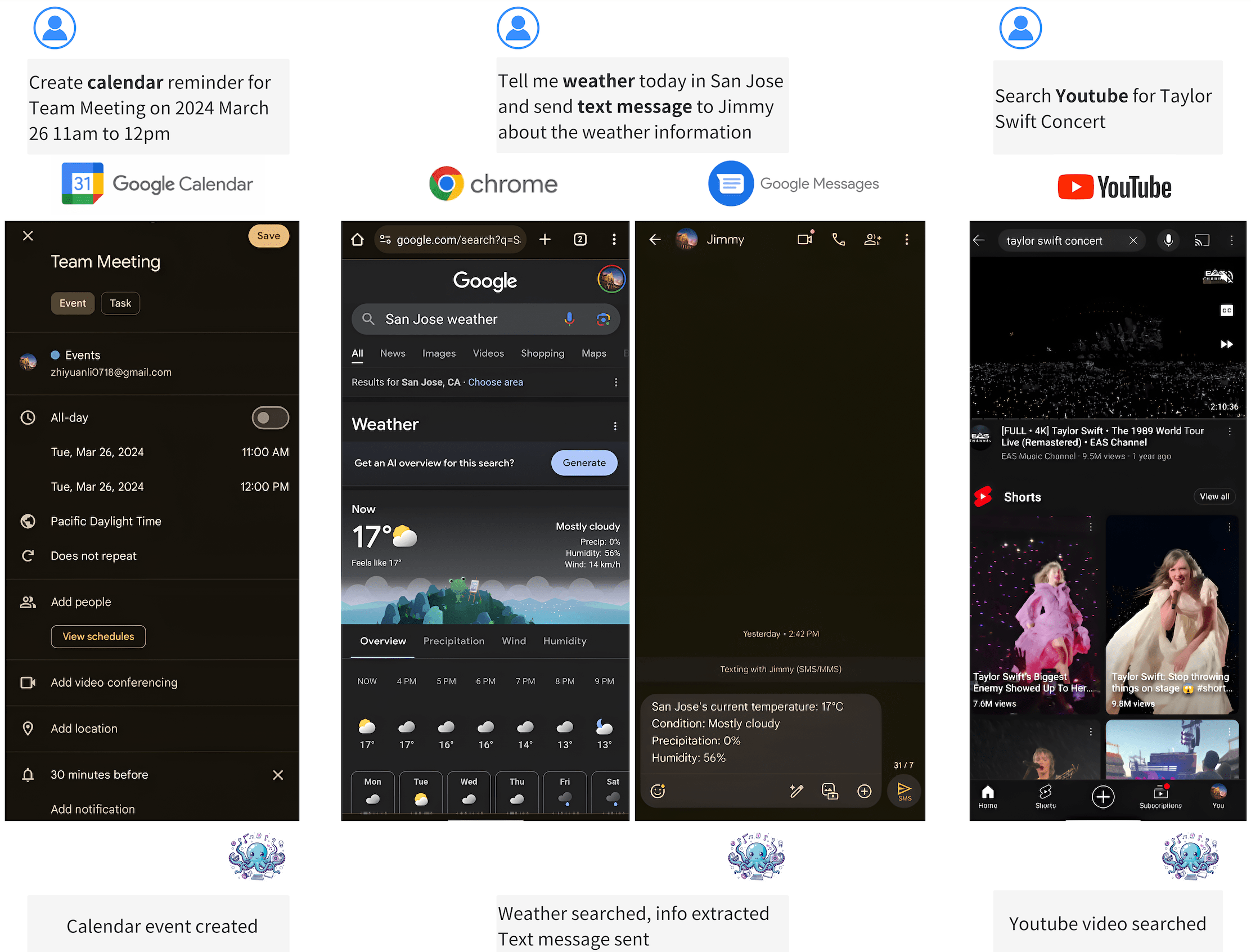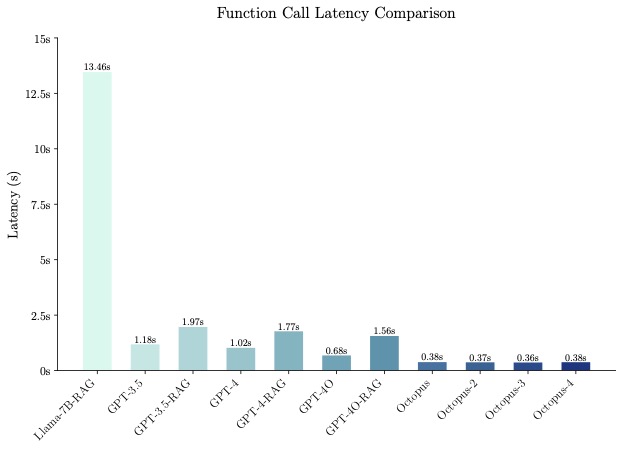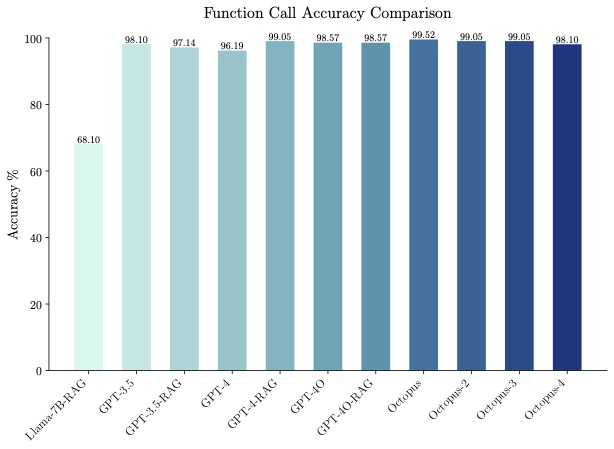Pour échanger, demandez l’accès au :
Nous avons le projet d’une infolettre, seriez-vous intéressé ?
Octopus v2 2B
04/04/2024
•Tags : AI, IA, LLM
Toutes les notes de veille : [[+ Sommaire veille]] Date de récolte : [[2024-04-04-jeudi]]
Octopus V2: On-device language model for super agent
Mon avis :
Ce modèle utilise un trick très malin, créer un token unique pour chaque fonction à appeler (plutôt que de recourir à du RAG). Ce trick est utilisé pour l'entraînement (à partir de données synthétiques) comme pour l'inférence. L'objectif est d'avoir un modèle pouvant tourner sur des devices Android, il doit donc être compact. Ses performances sont prometteuses.
Texte complet :
Introducing Octopus-V2-2B
Octopus-V2-2B, an advanced open-source language model with 2 billion parameters, represents Nexa AI's research breakthrough in the application of large language models (LLMs) for function calling, specifically tailored for Android APIs. Unlike Retrieval-Augmented Generation (RAG) methods, which require detailed descriptions of potential function arguments—sometimes needing up to tens of thousands of input tokens—Octopus-V2-2B introduces a unique functional token strategy for both its training and inference stages. This approach not only allows it to achieve performance levels comparable to GPT-4 but also significantly enhances its inference speed beyond that of RAG-based methods, making it especially beneficial for edge computing devices.
📱 On-device Applications: Octopus-V2-2B is engineered to operate seamlessly on Android devices, extending its utility across a wide range of applications, from Android system management to the orchestration of multiple devices. Further demonstrations of its capabilities are available on the Nexa AI Research Page, showcasing its adaptability and potential for on-device integration.
🚀 Inference Speed: When benchmarked, Octopus-V2-2B demonstrates a remarkable inference speed, outperforming the combination of "Llama7B + RAG solution" by a factor of 36X on a single A100 GPU. Furthermore, compared to GPT-4-turbo (gpt-4-0125-preview), which relies on clusters A100/H100 GPUs, Octopus-V2-2B is 168% faster. This efficiency is attributed to our functional token design.
🐙 Accuracy: Octopus-V2-2B not only excels in speed but also in accuracy, surpassing the "Llama7B + RAG solution" in function call accuracy by 31%. It achieves a function call accuracy comparable to GPT-4 and RAG + GPT-3.5, with scores ranging between 98% and 100% across benchmark datasets.
💪 Function Calling Capabilities: Octopus-V2-2B is capable of generating individual, nested, and parallel function calls across a variety of complex scenarios.
Example Use Cases

You can run the model on a GPU using the following code.
from gemma.modeling_gemma import GemmaForCausalLM
from transformers import AutoTokenizer
import torch
import time
def inference(input_text):
start_time = time.time()
input_ids = tokenizer(input_text, return_tensors="pt").to(model.device)
input_length = input_ids["input_ids"].shape[1]
outputs = model.generate(
input_ids=input_ids["input_ids"],
max_length=1024,
do_sample=False)
generated_sequence = outputs[:, input_length:].tolist()
res = tokenizer.decode(generated_sequence[0])
end_time = time.time()
return {"output": res, "latency": end_time - start_time}
model_id = "NexaAIDev/android_API_10k_data"
tokenizer = AutoTokenizer.from_pretrained(model_id)
model = GemmaForCausalLM.from_pretrained(
model_id, torch_dtype=torch.bfloat16, device_map="auto"
)
input_text = "Take a selfie for me with front camera"
nexa_query = f"Below is the query from the users, please call the correct function and generate the parameters to call the function.\n\nQuery: {input_text} \n\nResponse:"
start_time = time.time()
print("nexa model result:\n", inference(nexa_query))
print("latency:", time.time() - start_time," s")
Evaluation


Training Data
We wrote 20 Android API descriptions to used to train the models, see this file for details. The Android API implementations for our demos, and our training data will be published later. Below is one Android API description example
def get_trending_news(category=None, region='US', language='en', max_results=5):
"""
Fetches trending news articles based on category, region, and language.
Parameters:
- category (str, optional): News category to filter by, by default use None for all categories. Optional to provide.
- region (str, optional): ISO 3166-1 alpha-2 country code for region-specific news, by default, uses 'US'. Optional to provide.
- language (str, optional): ISO 639-1 language code for article language, by default uses 'en'. Optional to provide.
- max_results (int, optional): Maximum number of articles to return, by default, uses 5. Optional to provide.
Returns:
- list[str]: A list of strings, each representing an article. Each string contains the article's heading and URL.
"""
License
This model was trained on commercially viable data and is under the Nexa AI community disclaimer.
References
We thank the Google Gemma team for their amazing models!
@misc{gemma-2023-open-models,
author = {{Gemma Team, Google DeepMind}},
title = {Gemma: Open Models Based on Gemini Research and Technology},
url = {https://goo.gle/GemmaReport},
year = {2023},
}
Citation
@misc{chen2024octopus,
title={Octopus v2: On-device language model for super agent},
author={Wei Chen and Zhiyuan Li},
year={2024},
eprint={2404.01744},
archivePrefix={arXiv},
primaryClass={cs.CL}
}
Contact
Please contact us to reach out for any issues and comments!
